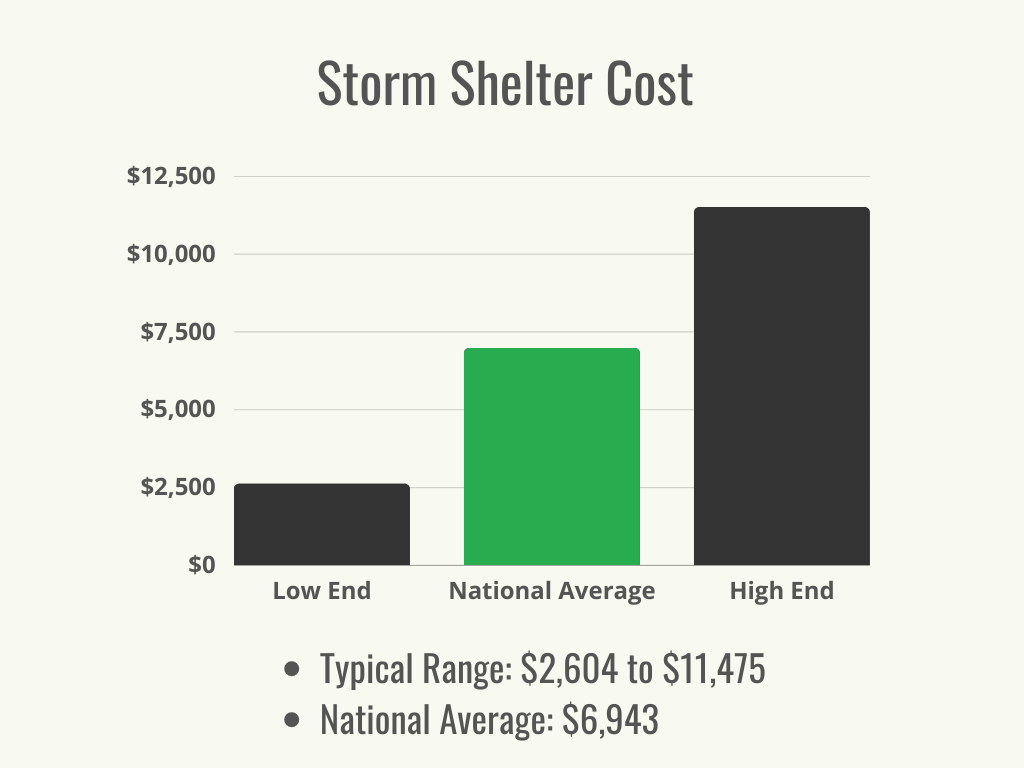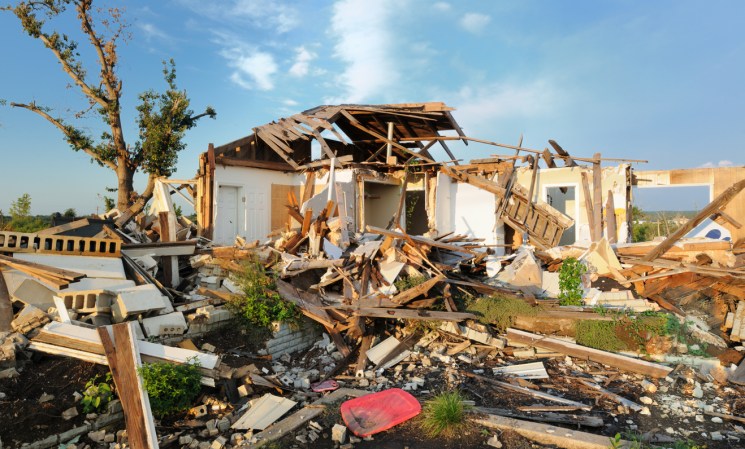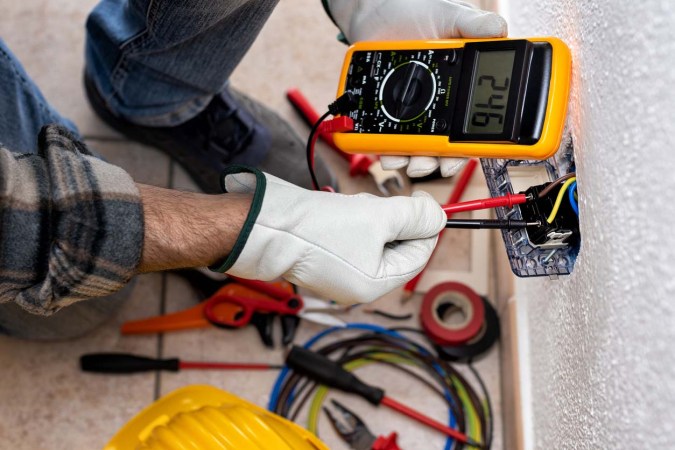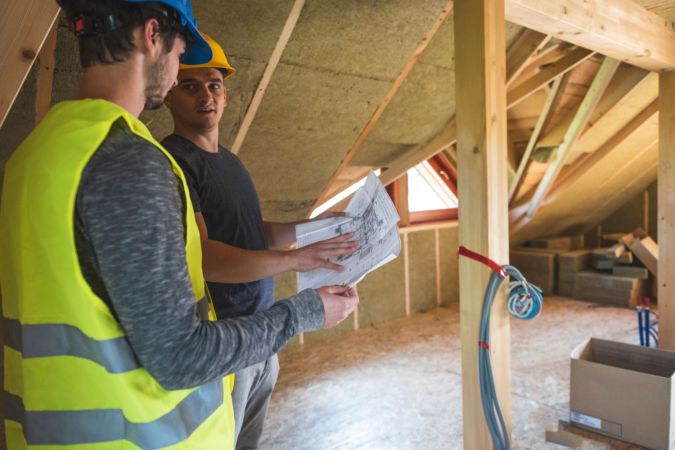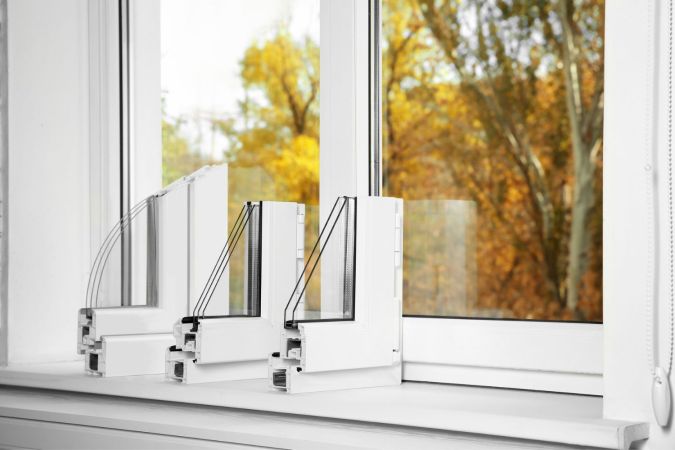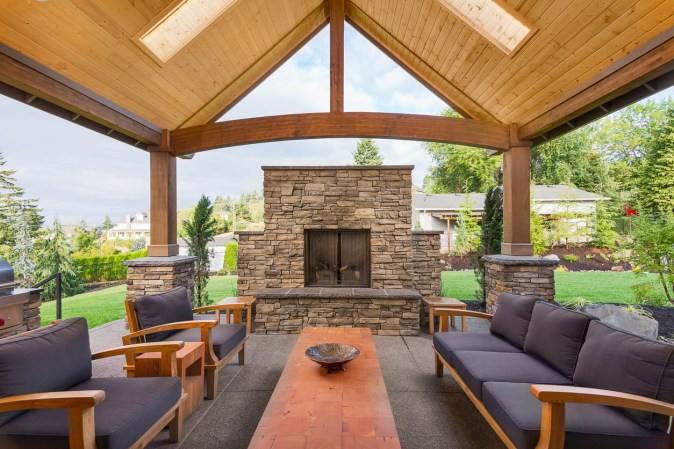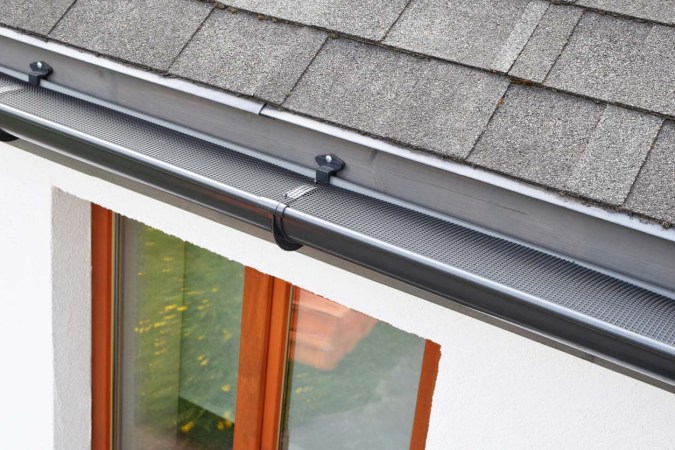We may earn revenue from the products available on this page and participate in affiliate programs. Learn More ›
Highlights
- The typical range for storm shelter costs is $2,604 to $11,475, with homeowners nationwide paying an average of $6,943.
- The most significant cost factors for building a storm shelter include the cost difference between custom and prefab structures as well as between inground and above-ground structures, the shelter size, delivery and installation costs, brand, and shelter material.
- Storm shelters can be a worthwhile investment, as they provide emergency protection, increase home value, can be easy to install, offer the potential for extra storage, and protect valuables.
- Some prefab kits can be installed by homeowners, but in order to have peace of mind that a shelter will provide adequate protection in a storm, it’s a good idea to have a professional build a storm shelter.
A destructive storm can pop up at any time, which means it’s wise for homeowners to be prepared rather than caught without safe shelter. Storm shelters come in a variety of shapes and sizes—even some prefabs—which means they come in a range in prices, too. A true storm shelter must meet federal safety requirements for withstanding winds and debris from extreme weather. According to Angi and HomeAdvisor, a storm shelter costs $2,604 to $11,475, with homeowners spending an average of $6,943.
Storm shelter costs are determined by the type of shelter, installation, materials, site preparation, and any special features. Storm shelters can be as simple as a basic safe shelter to hold a few people, or they could be decked out with shelving, plumbing, and a power supply. The benefits outweigh the cost, since this is a matter of life and death in many areas. During the course of planning this important project, homeowners can use the information below to understand what to expect for storm shelter costs.
Factors in Calculating Storm Shelter Cost
The cost of a storm shelter largely depends on the type of shelter that is being built. Some require a lot of construction, while others are fairly simple add-ons. In general, options include an above-ground or inground storm shelter, or a prefab or custom storm shelter. According to Jim Bell, director of operations at the National Storm Shelter Association (NSSA), “The [most] significant cost in making your own tornado shelter is the cost of the materials, which are products that are heavier than standard products because of the severe forces… [A] concrete slab to secure the shelter is also required.” Costs can also vary based on location and the current demand.
Prefab vs. Custom
Installing a prefab storm shelter can be a budget-friendly way to have a shelter and still meet standard safety requirements. Inground storm shelter costs for a small prefab model start at $3,000 with delivery and installation. Larger, above-ground structures cost $5,500 to $12,000.
Custom storm shelters can be built to suit any area. As with any custom construction project, it will cost more money, but it can also be built to a homeowner’s specifications. A small prefab shelter could cost as little as $3,000 to $8,000, but delivery and installation will add $1,000 to $3,000. Granted, a 5-foot by 5-foot by 8-foot shelter might not be large enough, so the cost could be higher if this is the case and the homeowner wants a bigger shelter. Homeowners can expect to pay up to $30,000 depending on the size of the shelter being built.
Above-Ground vs. Underground
An above-ground storm shelter costs a little less than an underground shelter. Many of these above-ground shelters are placed in a garage or basement. Garage storm shelter cost ranges from $3,000 to $9,000, while the average cost for all types of above-ground storm shelters could be up to $15,000.
An underground storm shelter costs between $4,200 and $30,000. These cost more, since they are more difficult to install due to the complexities of building underground. While underground shelters are more secure and take up less space, they are naturally prone to flooding, so homeowners are advised to talk to a local installer who knows how to build an underground storm shelter that is flood-resistant.
Shelter Size
Some prefab units come as small as 5 feet by 5 feet by 8 feet—small, but big enough to get the job done in a pinch for a few adults. However, it’s best for a homeowner to plan for about 6 square feet per person in areas with tornadoes and 10 square feet per person for hurricane-prone regions. An eight-person storm shelter will accommodate large families or a few neighboring households. This size could cost between $4,000 and $10,000. Below are the costs for a storm shelter to accommodate different numbers of people.
| Shelter Occupancy | Cost |
| 6 | $3,000 to $8,000 |
| 8 | $4,000 to $10,000 |
| 12 | $6,000 to $20,000 |
| 15+ | $10,000 to $30,000 |
Delivery and Installation
Many prefab storm shelters will include the cost of delivery and installation in their quoted price. If they don’t, these extra costs can add another $1,000 to $3,000 on top of the cost of the storm shelter itself. Homeowners will want to ask if delivery and installation are included in the storm shelter quote. In some cases one of the best home renovation contractors or best handyman services may be able to build a storm shelter, but in general it’s best for the homeowner to hire someone who specializes in this type of job.
Brand
There are several brands available for prefab storm shelters. They all meet federal safety regulations, and many companies have a variety of options available or they specialize in one type of shelter. It’s important for homeowners to research them carefully to make sure they service the area and offer important features such as long-term warranties, specific safety ratings, and different sizes and customizations. Below are some of the top prefab storm shelter brands and their prices.
| Shelter Brand | Cost |
| Atlas Survival Shelters | $5,000 to $15,850 |
| FamilySAFE | $3,600 to $13,050 |
| Fiberglass Creations | $4,800 to $6,500 |
| FlatSafe | $4,000 to $10,050 |
| Ground Zero | $2,950 to $11,950 |
| Hausner’s | $4,450 to $13,350 |
| Oklahoma Shelters | $2,600 to $11,000 |
| SafePorch | $3,400 to $12,250 |
| Southern Illinois | $3,750 to $12,050 |
| Storm Safe | $3,150 to $12,350 |
| Survive-a-Storm | $3,300 to $12,100 |
| Valley | $3,800 to $10,950 |
Shelter Material
A storm-safe shelter is built with durable materials, often with reinforcement to withstand the battering of debris and wind in severe storms. Many shelters are made of lightweight, durable steel and cost $4,000 to $30,000. Fiberglass is also popular, but it can only be used underground and comes at a cost of $3,000 to $10,000. Concrete shelters are heavy and durable with a price of $3,000 to $7,000, and they can be precast or poured. Kevlar storm shelters are the most expensive and durable at $5,000 to $30,000. This is a unique material that can even be added to an existing room, or it can be added to a prefab steel shelter for extra reinforcement. Below are the costs for each type of storm shelter material.
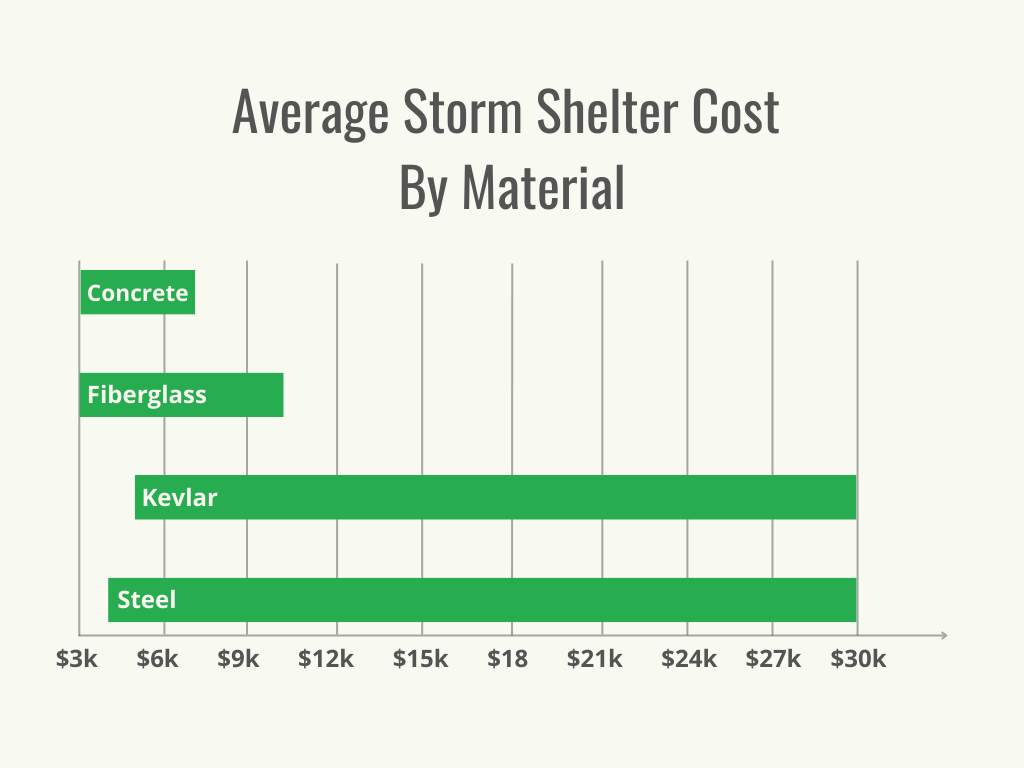
Additional Costs and Considerations
It’s recommended for a homeowner to consult with a pro to understand what type of shelter is best for their home and the area where it is located. The cost to build a storm shelter usually requires a few other budgetary considerations. Most locations will need some site preparations before installation, and there are often permits to obtain and local building codes to meet. These and other factors are explained below.
Site Preparation
Prefab units are designed to be easier to install with little extra preparation compared to a custom inground storm shelter. Still, it’s wise for a homeowner to consider what area is best for the shelter and to make sure there is no landscaping, garage equipment, or other objects in the way. The ground might also need leveling first, which costs $2,000 on average, and all prefab units must be anchored to a concrete pad or foundation.
Inground storm shelters typically require the most site preparation, since excavation will be required. Excavation costs an average of $3,200. This also means checking for underground utilities first. If any electricity, plumbing, or other utilities are added, those will need to be installed as well. It’s a good idea for a homeowner to ask whether the cost of site preparation is included in the total price of storm shelter installation.
Permit Requirements
In many areas, there are permit requirements to build a storm shelter. This might depend on the type of shelter being built. Permit costs could be as low as $50 to $100, but these could increase with the addition of utilities and other custom features.
Local Building Codes
The Federal Emergency Management Agency (FEMA) has standards that storm shelters must meet in order to be considered safe. The NSSA (National Storm Shelter Association) also has a thorough approval process for storm shelter brands. To be eligible for NSSA membership, companies must be evaluated by an approved third party and deemed compliant with a long list of criteria. According to Bell, “Not all shelters are alike. [Due to a] lack of proper inspections by building departments, a lot of shelters being sold do not meet the building code and shouldn’t be used. If you follow the FEMA requirements in FEMA P320 and use a tested door, you would be safe.” Reputable businesses will have shelters that meet or exceed FEMA and NSSA requirements. But beyond these, local or state governments might have additional requirements that apply to specific geographic, geological, or other situations for the area. Homeowners can speak with a local building inspector or municipality to learn about local building codes.
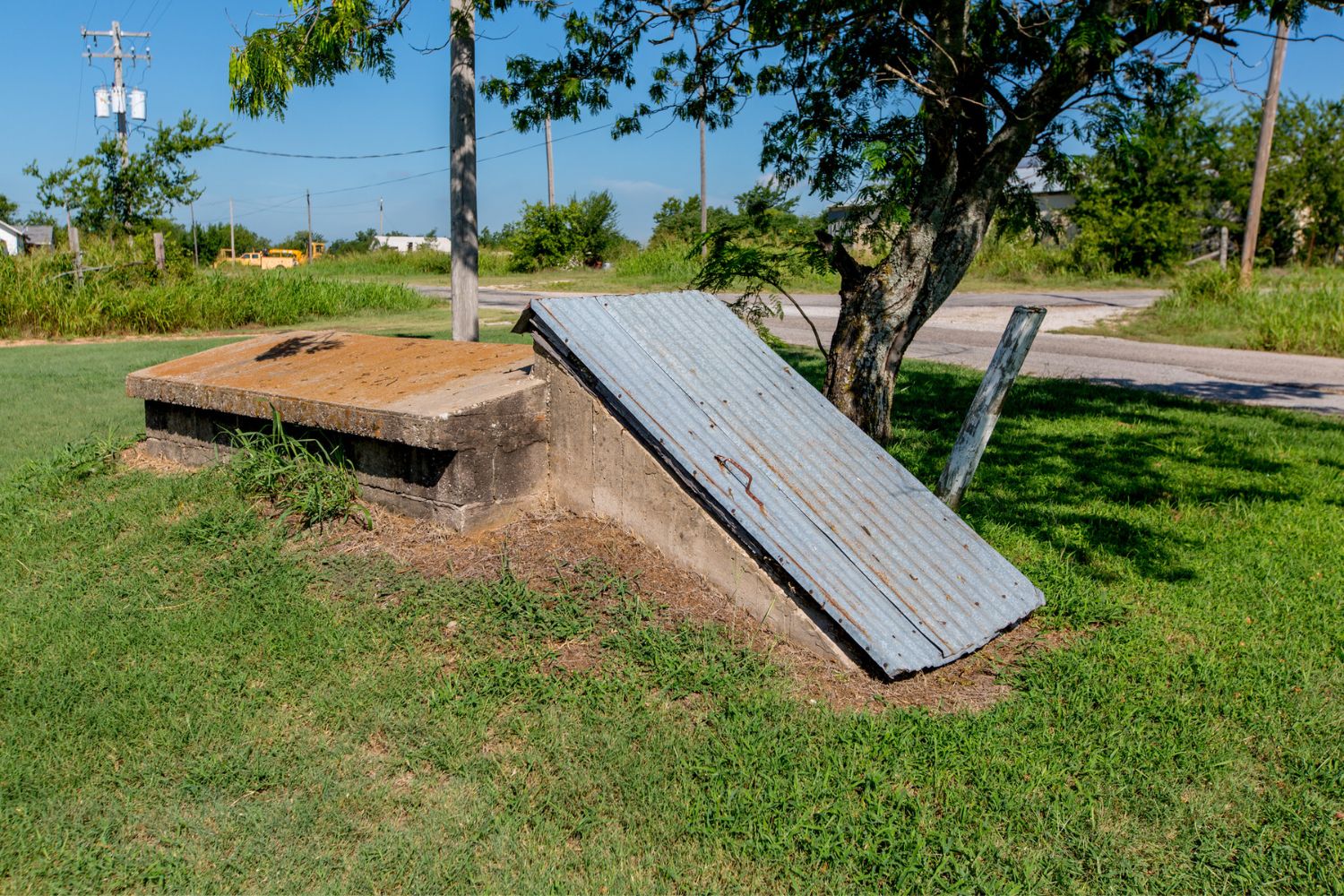
Accessibility
A key point to remember when planning a storm shelter is how accessible it is. Ideally, a storm shelter will be inside a homeowner’s property—or, at the very least, close by. Some tornadoes happen so quickly that there just isn’t time to get to a shelter that’s even 50 feet away. Beyond proximity, it’s important for a homeowner to consider how easily it can be accessed by a person with a wheelchair or someone who has limited mobility. A garage storm shelter or add-on is often the best choice in these cases, as it’s usually on the same level as the house.
Additional Systems and Features
Some storm shelters are built just to keep people safe during a short storm, while others are intended to remain a safe space for many hours to days. In the latter case, it may be necessary to install mechanical and HVAC systems to make sure the area is as livable as a house, in addition to being spacious enough. It’s even possible to include internet service, plumbing, extra ventilation, shelving, beds, and a secondary emergency exit. All of these will require custom construction and will come with a higher price.
| Feature | Cost |
| Beds | $300 to $400 each |
| Electricity or internet | $100 to $1,500 |
| Emergency exit | $500 to $2,000 |
| HVAC/filtration | $100 to $3,000 |
| Plumbing | $100 to $5,000 |
Types of Storm Shelters
The question of how much a storm shelter costs is largely determined by the type of storm shelter that is chosen. The following information can help homeowners understand each type of shelter and its associated costs while deciding which is the best fit.
| Storm Shelter Type | Cost |
| Above-ground | $2,600 to $15,000 |
| Basement | $6,000 to $15,000 |
| Bed | $2,100 to $4,500 |
| Garage | $3,000 to $15,000 |
| Inground | $4,200 to $30,000 |
| Secure room | $3,000 to $10,000 |
Above-Ground Shelters
Above-ground shelters are less costly than inground storm shelters, and they are fairly versatile in terms of where they can be placed. These are often prefab units that can be installed in a basement or garage, added onto the house, or installed in a bedroom. They’re also great for people with accessibility considerations. The main construction requirement is that they have space for a concrete pad under them. Homeowners can expect to pay $2,600 to $15,000 for an above-ground shelter.
Basement Shelters
For homes that have basements, building a basement storm shelter is a convenient and cost-effective way to go. Basement shelters need to be anchored to the concrete foundation, and homeowners will want to avoid placing them under anything excessively heavy on the main floor, such as a piano, refrigerator, bookcase, or safe. Basement shelter costs range from $6,000 to $15,000.
Bed Shelters
Sometimes a budget isn’t the only constraint on a construction project. If there simply isn’t space to add a storm shelter and it’s not possible to build one underground, then homeowners may consider installing a bed shelter. These are unique installations that meet FEMA requirements up to an E5 tornado. They are installed right under a bed, which can make them feel claustrophobic for some, although there are different sizes and shapes here, too. But they’re convenient to get to, especially in a smaller home or apartment. They’re also relatively affordable at $2,100 to $4,500.
Garage Shelters
Garages are also convenient spaces in which to build a storm shelter. They already have a concrete pad that can anchor the shelter in place. A garage shelter costs $3,000 to $9,000 to build—however, this means choosing a smaller shelter than usual, so this might not work well for large families. Some homeowners opt for an underground garage shelter, but these can be significantly more expensive, costing up to $15,000.
Inground Shelters
Inground shelters are the most secure and durable type of storm shelter, since they cannot be blown over by the wind or smashed by falling debris. These types of shelters can cost anywhere from $4,200 to $30,000, can be made from a variety of materials, and are available as prefab or custom shelters. The drawback is that some areas are not ideal for an underground storm shelter, since they could be prone to flooding. Still, it’s worth it for a homeowner to talk with a local installer, check the area’s topography, and have the soil tested to see if an inground shelter could work.
Secure Rooms
Secure rooms, or safe rooms (sometimes known as storm shelters as well), can also serve as what’s known as a panic room. Sometimes safe rooms are designed to protect against weather and intruders, so they are often customized with locks, surveillance equipment, and a landline to call for emergency services. But as long as they are built to withstand hurricane- and tornado-force winds, they can also serve as storm shelters as well. These rooms are usually inside the home and easily accessible. Homeowners can expect to pay between $3,000 and $10,000 for a secure room.
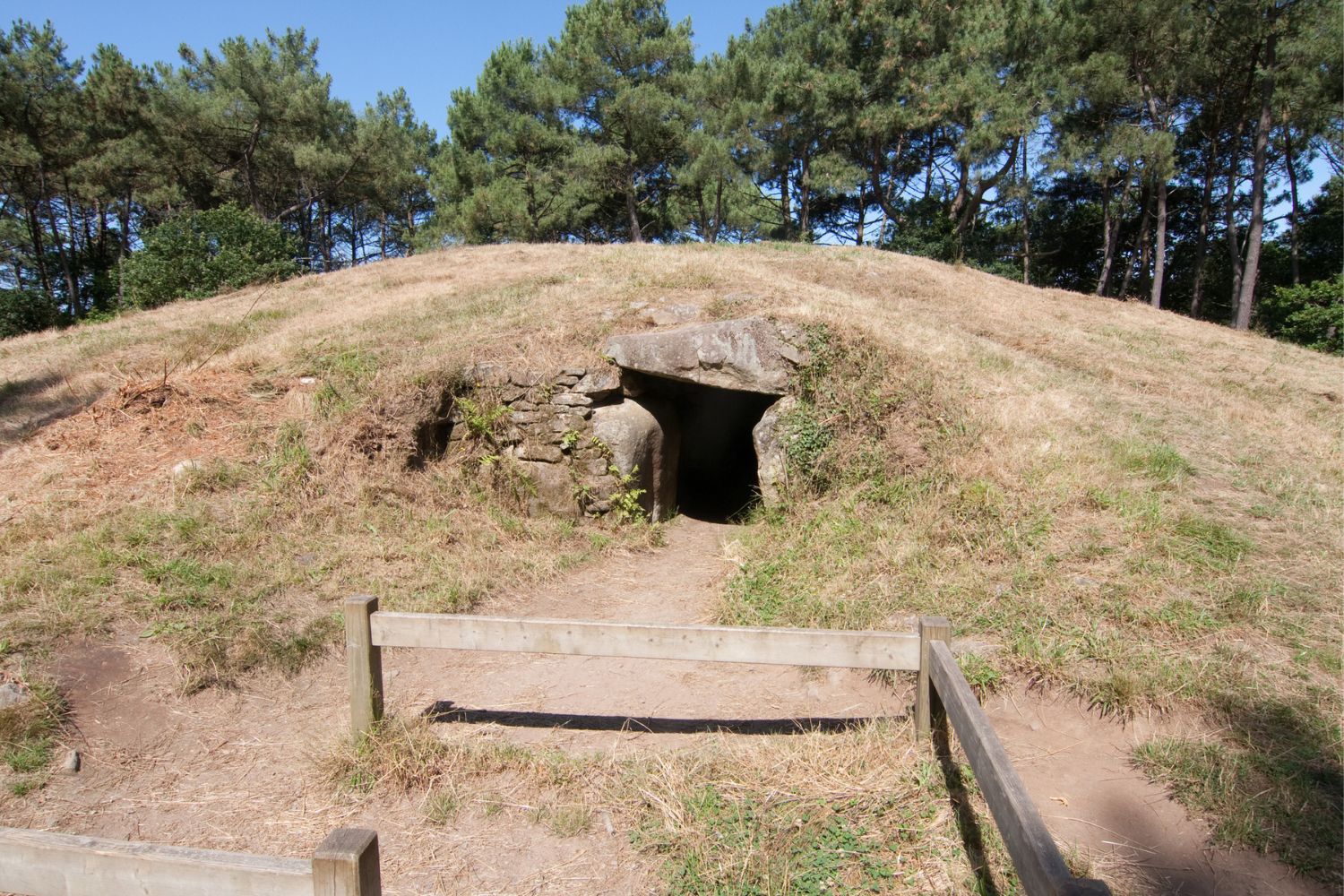
Do I Need a Storm Shelter?
Some areas of the country are not prone to predictably wild weather. On the other hand, many states regularly experience the full force of Mother Nature during tornado season or hurricane season. “The first sign would be if your home falls within the 250 mph wind zone, which consists of all or part of 25 states,” says Bell. “You can also find paths of tornadoes of the past to assess how vulnerable you may be.” For those who live within the area known as Tornado Alley (in states such as Oklahoma, Texas, Kansas, Nebraska, Iowa, and South Dakota) or along the southern or eastern coastline, having a storm shelter is a good idea.
Hurricanes and tornadoes are the two most severe weather patterns experienced in the U.S. Homeowners in areas that endure severe hurricane seasons may opt to pay the cost to install hurricane windows or the cost to install hurricane shutters rather than paying to build a storm shelter. Those in areas without frequent severe weather may also prefer the relatively low cost of a storm door to help protect them. The Midwest relies more on storm shelters that other areas do. Still, shelters have distinct advantages for any area, since they are designed to keep people safe and not just the windows or house.
Benefits of Installing a Storm Shelter
Storm shelters are built using different methods than a home; they are constructed specifically to protect people against damage and extreme weather. They may seem pricey, but they can be built for as little as $2,604. Residents in areas at high risk for storms may look into hurricane-proof modular home costs to see if this option will work for them, but at $270,000 this option is much pricier than a storm shelter, which can be built for as little as $2,604. Their primary benefit is that they provide a truly safe space in case of an emergency, but they can also increase a home’s value and easily store emergency provisions.
Protection and Safety
Most homes are sturdy enough for regular thunderstorms, but they may be unable to withstand the forces of a direct hit from a tornado. That’s where a storm shelter’s benefit truly lies: they are versatile enough to protect from a variety of threats. According to Bell, “The emergencies we design for specifically are tornadoes and hurricanes. I have seen these used as home invasion safe rooms with few modifications, and bomb shelters also on a few occasions.”
Increased Home Value
Almost any add-on that offers the benefits of comfort or safety will increase home value, and storm shelters are no different. It’s estimated that 50 percent of the cost will help to boost a home’s value, particularly in areas prone to extreme weather. Additionally, if the storm shelter is used for other purposes, such as securely storing wine or firearms, the value increases thanks to the dual functionality.
Ease of Installation
Above-ground storm shelters are fairly easy to install, especially if they are prefabricated and don’t need HVAC systems. That means a safe space can be installed rather quickly and easily without disrupting the rest of the living space.
Storage for Emergency Provisions
Storm shelters, particularly ones that are underground or in a basement, can make great spaces for storing emergency provisions. In fact, FEMA recommends storing enough water and food for a few days in the storm shelter. If possible, homeowners may want to consider building a storm shelter large enough to hold family members as well as all emergency provisions needed for at least a week, including food, water, hygiene and bathroom necessities, blankets, extra clothes for all seasons, flashlights, batteries, and more.
Protection for Valuables
Many people who live in areas with violent weather will collect antiques and valuables to take with them to the shelter during a storm. In fact, the safe room is often used as a storage place for those items when they are not on display. While homeowners insurance may cover the cost of tornado damage or the cost of items lost in a storm, there is no replacing one-of-a-kind sentimental belongings once they are gone. Since a storm shelter is a safe place for humans, then old photographs, family heirlooms, jewelry, and other valuables will also be safe.
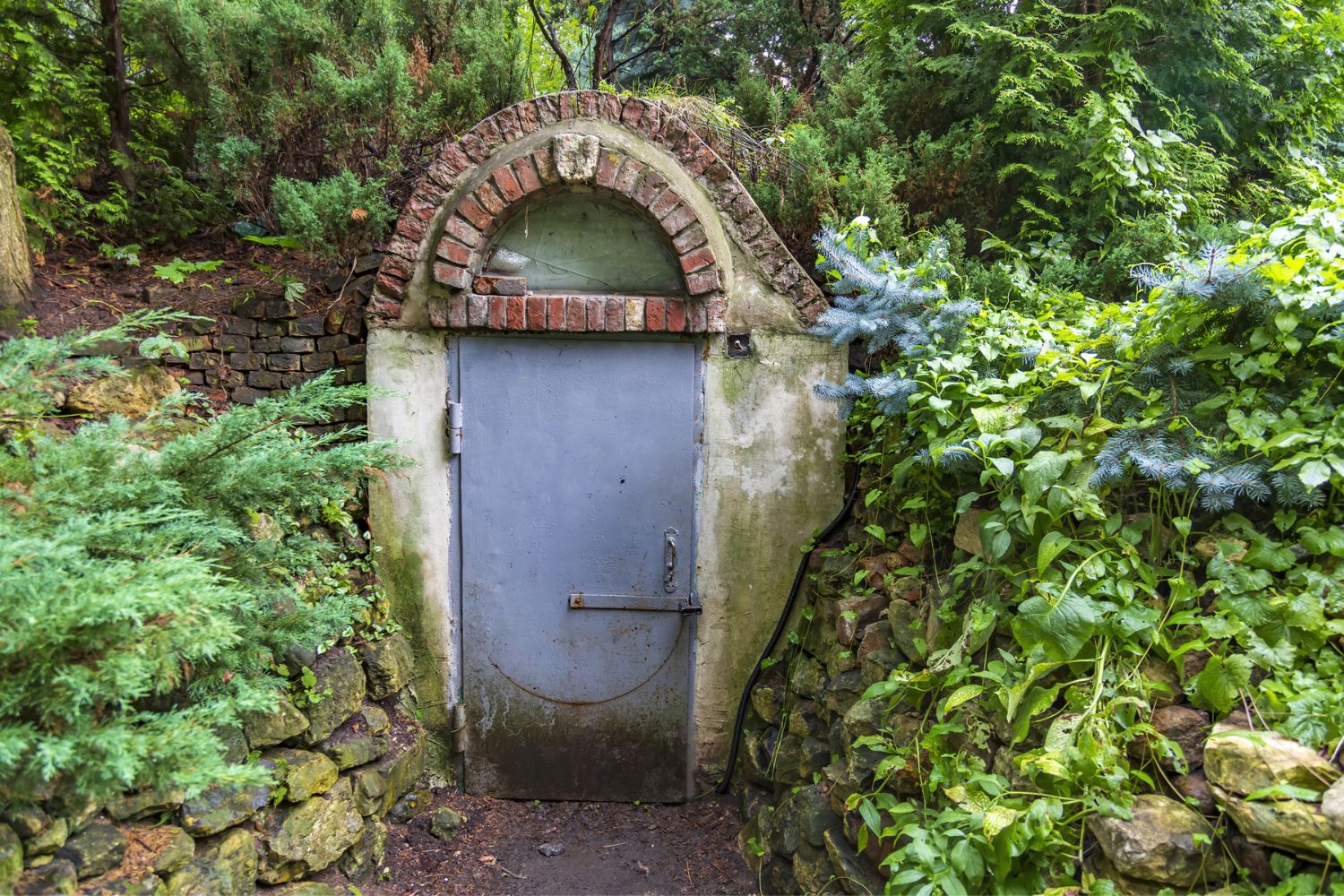
Storm Shelter Installation: DIY vs. Hiring a Professional
It may technically be possible for a homeowner to learn how to build a storm shelter without a professional, but the reality is that it’s unlikely that the shelter will meet standard safety criteria and hold up in extreme weather. DIY prefab storm shelters can be purchased for above ground, but the most reputable and safest options are only available through licensed brands who sell top safety-rated shelters and install them. This is one area where it’s vital to be able to trust the safety and security of the structure in an emergency, so it’s usually best for the homeowner to leave it to a pro installer. Professionally built storm shelters also undergo testing to ensure that they can hold up to extreme winds. For example, “The opening protectives, doors or windows are required by code to be tested for impact and be labeled with the testing parameters that it passed,” says Bell. “The openings are the weakest component of the shelter because it not only functions as a door or window but has to withstand multiple impacts by a 9-pound 2×4 fired at 100 mph. Any standard door assembly can not withstand this test.” The average homeowner will not have the resources or expertise to verify that their homemade shelters meet these criteria.
Particularly for an inground storm shelter, it’s important for a homeowner to leave the task to a licensed company who is familiar with safety standards and special building procedures that can literally mean the difference between life and death. Also, opting to build a storm shelter with an HVAC system or with plumbing or electrical connections will require the assistance of pros who are licensed to work on those systems.
How to Save Money on Storm Shelter Installation
As you ponder the question “How much does a storm shelter cost?” remember that there are ways to help save on a storm shelter cost. The following are several ways to reduce costs while planning this important project.
- Consider a prefab storm shelter. These models are easy to install and don’t require a lot of site preparation.
- Don’t start from scratch. Build your storm shelter above ground in an existing space (like a basement or garage) if possible.
- Opt for installing bed shelters. These are some of the most affordable shelters if space and money are truly limited.
- Choose materials wisely. Avoid choosing the most expensive material, since all of them are rated for safety.
- Shop around. Speak with multiple companies to determine what actually meets your specific needs and budget.
- Make it multi-use. Consider how to use the storm shelter for more than one purpose to increase the overall value for yourself and the home.
- Start small. Alternatively, keep the shelter to a minimum with just enough space for your family and a few emergency provisions. You can always add on space and extra features later.
- Apply for help. Ask about receiving financial assistance from FEMA through an application process that could provide up to 75 percent of the funding.
Questions to Ask About Storm Shelter Installation
It’s important for a homeowner to build the right storm shelter to make sure it fulfills safety requirements. It’s essential that the storm shelter is built by a reputable and licensed company who is qualified to provide a shelter that meets or exceeds safety standards. While deciding which company to hire or purchase a shelter from, homeowners can use any of the following questions to guide the decision-making process.
- Do you require a deposit or payment up front?
- Do your storm shelters meet local building codes for my area?
- Do your storm shelters meet FEMA safety standards?
- Are your prefab shelters made for inground or above-ground installation?
- How big should I build a storm shelter for six people and provisions?
- Are there accessibility-friendly storm shelters?
- How can I make an inground storm shelter more accessible?
- How close to my house should I build my inground storm shelter?
- Do I have to have ventilation in my storm shelter?
- What happens if my house collapses on my basement storm shelter?
- Is a bed shelter a good option for my house?
- How much site preparation will you have to do?
- How long will it take to install the storm shelter?
- For this custom storm shelter, do you subcontract out any of the labor?
- How much are the delivery and installation of this prefab storm shelter?
- How can I make sure I have lights in my storm shelter if the electricity is down?
- How can I save money on this project?
- Once it’s installed, is there any maintenance or things to watch for to make sure the storm shelter is in good condition?
- What kind of warranties or guarantees do you offer?
FAQs
Installing a storm shelter isn’t the cheapest project to take on, and there are some complexities to work through while homeowners are deciding which option is best. The following frequently asked questions can help clear up any remaining confusion and alleviate concerns when homeowners are considering this wise investment.
Q. Is a tornado shelter worth it?
For those who live in an area that’s prone to tornadoes, then a storm shelter is definitely a wise investment. Homes are simply not built to withstand winds and debris being thrown by destructive storms, and many areas do not have basements, which are only a slightly safer place to hide in a home. A storm shelter provides people with a safe space to ride out a storm with access to emergency provisions and even light as long as preparations were made ahead of time. Those in areas with fewer tornadoes who have made their basement tornado ready may not need to install a storm shelter, but doing so anyway can provide additional peace of mind that they and their family will be safe if the worst should happen.
Q. How do storm shelters keep me safe?
True storm shelters are made of materials and special equipment that has been tested in tornado-force winds to ensure they will not break or shatter. Wood or brick walls are simply not strong enough to do the job, particularly when a tree or car is hurtling toward them. However, a steel, concrete, or Kevlar structure is significantly more durable and will provide much more protection against wind and debris.
Q. Is a storm shelter safer than a basement?
Yes, it is. While a basement is better than any other floor of the house, a storm shelter provides better safety than just a basement. For instance, choosing to hide in a corner of the basement underneath the kitchen fridge on the main floor becomes dangerous if the floor collapses. In addition, many basements have large windows which can shatter in a severe storm and cause injury. A storm shelter that’s in the basement or any other location will be built to withstand winds, debris, and even collapsed materials on top of it.
Q. Where is the best place to put a storm shelter?
Ideally, a storm shelter should be close to the house—very close. Some tornadoes appear rather quickly and there isn’t time to get to a storm shelter a few hundred feet away. The best place for a storm shelter is either in the home or garage, added onto the house, or underground right next to the house so it isn’t necessary to walk through flying debris. Make sure to consider accessibility needs while consulting with a pro about where to put a storm shelter.
Q. How do you make a homemade storm shelter?
A homemade storm shelter likely won’t provide adequate protection against tornadoes and hurricanes. There are always risks even with digging your own shelter as it could collapse if it’s not properly installed, and if the doors are not secure, they could be ripped off by violent winds. Homeowners may choose to purchase a prefab storm shelter and install it if they have a strong background in construction, but the best route is to leave this to a professional company that can ensure the materials meet safety standards.
Q. What is the heaviest thing a tornado has picked up?
We know that tornadoes are capable of picking up and tossing cars and semis, but they’ve also been recorded picking up locomotive trains, too. The engine of a train weighs about 368,000 pounds, so that’s quite a bit of force! There are also plenty of videos showing airplanes at airports being pushed into jetways, so it’s likely a tornado can pick up a 747 plane.
Q. Are brick houses safer in a tornado?
Brick houses are safer than wooden houses due to their construction, especially if they are in good condition and only one story high. However, it’s best not to presume a brick house will survive the force of a car being thrown at it, nor whether it can withstand an F4 or F5 tornado. A storm shelter is still the best option of all to keep everyone safe.
Sources: Angi, HomeAdvisor, Fixr
